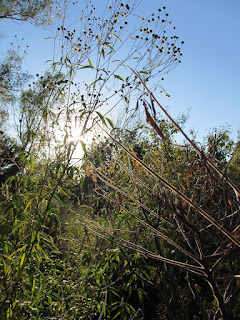I'm two years late to the party, but I just finished Travis Beck's book,
Principles of Ecological Landscape Design. It was incredibly life-affirming and instructive. But what really impacted me was how so much of what he was discussing I've intuited over the years experimenting, walking prairies and meadows, and now designing gardens (including doubling the size of my own in 2016). Here's just a little of what I mean:
"For long term stability in the face of environmental fluctuations, broad-scale resistance to pests and pathogens, and the ability to continue to evolve, genetic diversity in a plant population is essential. This is as true in the constructed landscape as it is in nature. To benefit from these advantages of intraspecific diversity, designers should use cultivated varieties selectively, consider developing regional or site-specific landraces, and insist on broad-based collection of seed for the production of straight species for landscape use."
As most of you know, I design gardens using as close to 100% straight species as possible, and when a cultivar is called for it's at least a wild-found species, not a lab-crossed hybrid. It will be interesting to see how these species fare in urban environments as the climate changes, and how their genetics will change.
"A little explored ecological approach to designed plantings is to allow self-thinning to maintain the balance between plant diversity and plant size. Applying self-thinning principles, the number of plants to include depends not on the ultimate number desired [old school thinking], but on the size at which they are planted -- either fewer larger plants or more smaller plants. In either case, plants should be planted in numbers necessary to fill the desired area, at such spacing that as soon as they are established, they face intraspecific competition."
I have literally backed my way into designing gardens in the above ways (and more in his book -- the guy is not a butterfly bush fan). I'm not saying I'm a genius, simply that while working with plants I felt what was happening and what was going to happen, and what I and the plants together desired to happen and feared would happen. My gardens are planted thickly for many reasons, from wildlife cover to conserving soil moisture (green mulch) to mimicking prairie habitat -- but now I see I was also trying to foster competition, rich competition, and a gene pool that interacts with the wilder prairies near my home (also thinking about wildlife corridors).
If every landscape in my city had a native plant garden we'd have wildlife corridors and resiliency up the wazoo. Maybe it's time to start a project that fosters this action here in Lincoln.
And now off to read Thomas Rainer and Claudia West's hot-off-the-press book,
Planting in a Post-Wild World: Designing Plant Communities for Resilient Landscapes.





















